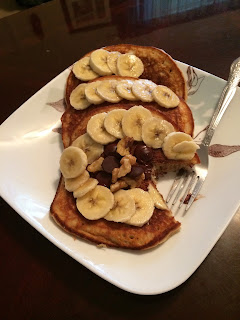Even more perfect is the fact that I can use those old, almost black bananas I took from the dining hall instead of throwing them away. Many bananas have been put to good use in this way. Ask my best friend who has been enlisted as taste-tester for variations on these pancakes for the past two years. She will also likely hint that, though tasty, I have never been able to achieve fluffy banana pancakes. Banana-y? Yes. Nutty? Yes. Moist? Certainly. Fluffy? No can do... until now. Thanks to Sal at Allrecipes and the fact that I only had one banana, I finally tweaked a recipe enough to get just what I wanted: fluffy and moist banana nut pancakes with some chocolate chips.
Ingredients (makes ~6 medium pancakes):
- 1 c flour
- 1/8 tsp salt
- 1 tsp baking powder
- 1 tsp sugar
- 1 banana
- 1/4 c each sour cream, vanilla yogurt, milk (if not vanilla, add 1 tsp vanilla extract)
- 1 egg
- Dash almond extract
- 1/4 tsp cinnamon
- chocolate chips
- walnuts
 Mix together the dry ingredients. In a separate bowl, mash the banana. Add the sour cream, yogurt and milk to the banana. Stir in the egg, almond extract and cinnamon. Now combine the wet and dry ingredients, but be sure not to stir too much. This will cause the gluten network to break down (and then no fluffy pancakes). If the batter is too thick, dilute with water as desired.
Mix together the dry ingredients. In a separate bowl, mash the banana. Add the sour cream, yogurt and milk to the banana. Stir in the egg, almond extract and cinnamon. Now combine the wet and dry ingredients, but be sure not to stir too much. This will cause the gluten network to break down (and then no fluffy pancakes). If the batter is too thick, dilute with water as desired.
As you heat a pan, allow the mixture to rest. Melt a small piece of butter in the pan to keep the pancake from sticking. Stir the batter once more (no more than 5 strokes!) and then ladle into the preheated and oiled pan. Sprinkle on chocolate chips and walnuts to your heart's content.


Flip when the pancakes edges have begun to solidify and bubbles appear throughout (middle photo above). Allow the other side to cook and then serve with extra banana, chocolate, and walnuts.


Flip when the pancakes edges have begun to solidify and bubbles appear throughout (middle photo above). Allow the other side to cook and then serve with extra banana, chocolate, and walnuts.
See Sal for the original recipe.


